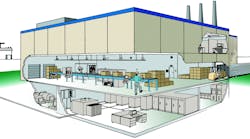The latest article in EW's continuing series on key end-user markets explores the sales opportunities awaiting distributors in America's schools.
Editor's note: This article will cover sales opportunities in K-12 public schools. Because the sales and marketing strategies distributors need to learn to sell to colleges and universities differ some from this market, a future article will cover that market segment.
That school down the road can provide more than an education for your town's children. For electrical distributors, independent manufacturers' reps and electrical manufacturers, schools offer a wealth of electrical product sales if you know how to work the system and get involved on the ground floor.
Most salespeople probably drive right past schools on the way to their big accounts such as electrical contractors or industrial plants. But several very good reasons now exist for salespeople in the electrical business to take a new interest in schools as potential customers for electrical products. For starters, there's more action in the school market these days because of a far-reaching demographic trend. Baby Boomers have produced offspring at a near-record pace, creating a surge in elementary school enrollment. To provide seats for these students, school districts in many areas of the U.S. are expanding older schools or building new schools in eye-popping numbers. Between 1997 and 1999, school districts will spend $31.7 billion on the new construction or renovation of schools, according to American School & University magazine.
The school market may also get some additional federal funding to stimulate new infrastructure construction. In March 1997, President Clinton announced a proposal, "The Partnership to Rebuild America's Schools," that would pump $5 billion into rebuilding schools this year. That proposed legislation has not yet come to a vote on Capitol Hill, but it sends a clear signal that the Clinton Administration wants the federal government to invest in America's schools.
Local, state and federal school-related organizations are all trumpeting the need for new schools or major retrofits of existing facilities. Carla Claycomb, director of the Policy Clearinghouse for the National Association of State Boards of Education says, "Six thousand new schools need to be built over the next decade to meet the demand. Last year 522 new schools were built."
While it's pretty clear huge opportunities are ahead in new school construction, don't overlook the sales potential in the retrofit of existing schools. According to some government statistics, 75% of all public schools are at least 25 years old. Electrically speaking, this means a ton of potential sales in the upgrade of equipment, from load centers at the service entrance to the power wiring and various low-voltage systems throughout the entire building. The core distribution systems in schools require many of the same products used in the commercial or industrial facilities with which electrical distributors are more familiar. But the school market requires a slightly different package of products because of how schools operate and the learning activities that the electrical and electronic systems there must support.
The chart on the next two pages highlights some of the key products that distributors can sell to schools. Of the products listed there, most of the action is in the following product areas:
*Energy-efficient lighting systems; *Dimming systems; *Wireway, surface raceway and underfloor duct; *Upgraded grounding systems to protect computer equipment from interference from power wiring and other equipment; *Datacom and low-voltage wiring systems for computers, local-area networks (LANs), video, television, security, intercom, fire alarms, and telephones; *Surge suppressors and power conditioning equipment to protect electronic equipment; and *Vandal-proof lighting.
The school market is seldom an area in which a distributor develops a specialty because the day-to-day sales potential just isn't as high as with core customers such as electrical contractors or industrial plants. But when a new school is being built, an addition to existing facilities is underway or a lighting or datacom upgrade is on the drawing boards, distributors should know what will be expected of them if they win the bid. Following are the key strategies that distributors should focus on to build a business in the school market.
Familiarize yourself with the bidding process. Because most major construction projects at public schools are financed by local or state funds, an open bidding process is used. Once the architect and engineering firm complete their plans and those plans are approved by the school district, general contractors bid the job. The general contractor that wins the bid then requests bid proposals from the various trades. If he or she believes the bids are realistic, the subcontracts are awarded; if not, the subcontractors bid again. The contractor that wins the bid for the electrical work then puts out his bid for materials to electrical distributors. According to Bob Fitzsimons, senior consultant at Information Transport Enterprises, New Canaan, Conn., a design and engineering firm that specializes in school construction, the datacom work on a project is often treated as a separate bid. However, he says it's easier to coordinate a job if these bids are combined. "There's a slight trend in this direction," he adds.
Performance clauses regarding maintenance of the power wiring or low-voltage wiring and other specific services are now often part of the contract, he says. "Maintenance of the system is very important, because it has to be working all the time. We have been adding it to the contractor's bid document, and the requirement is not to just pull in some cable and warrantee it for five years.
"What's being added are response time and performance criteria for fixing any downtime problem. This could be a 24-hour-emergency-service clause, a two-hour-response time for fixing a problem or a technical-support hotline. You never saw this in the past."
These performance clauses are particularly important with datacom communication systems because of how much schools have come to rely on their computers, he says.
Treat a school system as you would any other key account. The school construction market many never represent a large portion of your business. But it's so close to the core customer groups for many electrical distributors that it makes sense to service it just like you would other key accounts, with a salesperson consistently calling on the key buying influences in the market and at the school system.
Tap into your community's grapevine for early news of a school project. Your network of local contacts in the community can also help you get an early lead on new school projects. The new construction or retrofit work at schools is often well publicized through town meetings and local newspapers' coverage of those meetings. Most of the time this work has to go to vote before the community for approval, so you will find out about an approved project far in advance of when the work starts.
"If distributors get in on the ground floor, they can not only help with the construction phase, but with the MRO," says Ed Miller, vice president, marketing, The Wiremold Co., West Hartford, Conn. "For a distributor it should be a constant goldmine," he says. "A typical school room has a television monitor, fire and time systems, intercom, a computer for the teacher and more computers at work stations for the kids. And there are always renovations. For instance, with a wire management system in a school, the 'go-with' opportunities are tremendous. Not only are you selling a surface wiring system, but you have to have a proper grounding system and better separation between clean and dirty power."
Find out which manufacturers are calling on your market's buying influences. Lighting manufacturers, premises wiring companies and other manufacturers are focusing on the school market as one of the best sales opportunities in today's electrical industry. They often have field engineers calling on specifying engineers in your market to get their products specified. If you haven't met these field engineers, make it a point to do so.
Talk to the right people in the school district. For the big project work and retrofits, you have to find out who calls the shots on equipment purchases. The person with this purchasing power often reports to the superintendent and may be called the "business manager" or "energy manager," says John Wilson, manager of marketing and sales operations, Osram Sylvania, Inc., Danvers, Mass. "Don't just talk to the maintenance guy at the local high school who is working on a budget. You have to get to the business manager or the energy manager. Some schools are more sophisticated and have an engineer."
Get on the preferred vendor list and then sell up. If a school construction project is state-funded, there may be a preferred or recommended vendor list set at the state level that the local school districts follow. In some product areas, notably lamps, getting on state contracts is a one-way ticket to low-margin business. However, the local municipalities or school districts often can still choose their own brands if they so desire, says Osram Sylvania's Wilson. "They may say, 'We want to bid locally. We don't want the state brand.' This gives the schools that option."
If a distributor does opt to go for the lamp contract and has to service it at a relatively low margin, they can still use that business as a door-opener to sell the schools other products, hopefully at higher margins, says Wilson.
Sell the dollars-and-cents savings of energy-efficient lighting systems. Schools are particularly receptive to the concept of slashing operating costs by installing more efficient lighting systems. It's probably going to be your contractor who has the direct contact with the specifying engineers designing a school project or the school administrators that approve it. But you still should be prepared to offer yourself as a local source of lighting knowledge, if that's an area of expertise for your company.
Lighting retrofits are one of the very top facility improvements that schools invest in, as you can see by the factoid, "Retrofit Work" on page 38. It's right up there with installing air conditioning and carpeting. T-8 lighting systems, big-time dimming systems, vandal-resistant lighting, theater and sports lighting and energy-efficient exit sign lighting are a few of the top lighting opportunities for distributors.
Don't be surprised if your or your contractor customer find yourselves competing with energy-service companies (ESCOs) on lighting bids. ESCOs bid jobs by offering a one-stop solution to the design, installation and supply of products for not only the electrical portion of the job, but the HVAC segment as well.
Think low-voltage. Computer learning is as big a part of the curriculum as reading, writing and arithmetic. This is great news for any distributors considering a move into the low-voltage wiring market, or companies that already have established businesses in this area. Distributors' customers are pulling miles of spaghetti wire through the ceiling tiles to link computer labs to classrooms, and classrooms to the front office or Internet. And once a base of computer equipment is installed in a school, distributors can expect repeat business as the school reconfigures, updates or adds to its computer network.
The surge of interest in teaching computer skills and computer-based learning has put the market for low-voltage wiring, connectors, wall jacks and all the related datacom equipment one of the top opportunities in the school market (See the sidebar on page 36, "An Insider's Look at the School Market").
Focus on selling surge suppressors and other power-protection products. Find out which manufacturers of surge suppressors and other power protection products are doing to get this equipment specified on school construction jobs in your market. Schools store data such as grades, test results and other student records on their computer networks, and they need the proper protection so they don't lose this valuable information. Engineers are specifying surge protection equipment and uninterruptible power systems (UPS) to protect this information. Many retrofit jobs now have surge suppression devices at the subpanel and at the equipment outlet, especially in older buildings.
If school enrollment is on the rise in your market, you will be hearing more about new construction and retrofit work at schools. With the basic sales and marketing strategies discussed in this article, you can be ready for these opportunities when they develop.
With more than 16,000 school districts representing in excess of 110,000 schools, the education market is a significant opportunity for telecom cabling designers and installers-and the distributor that supply this equipment.
The decision-makers in a public school system don't initiate the same logical business judgments as clients in the commercial or industrial market. When contractors bid these jobs, they must set the contract price high enough to make up for the extra time required to negotiate and complete the selling process.
In addition to curriculum applications and issues, the installer should consider the administration and engineering aspects of the school. Recognize also that local administrators and educators are often part of a regional plan for using remote resources. Thus, a contractor who understands the business aspects of schools, as well as the technical aspects of cabling systems, will be more effective. Many schools rush to get wired without a plan, and few budget funds for upkeep and replacement. With limited knowledge about the new technologies, school officials can easily make major mistakes in their projects.
A school must be committed to supporting the infrastructure. Even schools that annually budget funds for technology often fail to invest in computer experts who can keep their complex systems running smoothly. Fewer than one in 10 schools hire full-time technology coordinators, according to a report by the Software Publishers Association.
Bob Fitzsimons, senior consultant at Information Transport Enterprises, New Canaan, Conn., follows the installation and upgrade of low-voltage wiring systems in schools for computers, telephones, video, television and other applications. He has prepared design and specification for school telecommunications systems since retiring from IBM.
Fitzsimons says many schools' cabling systems cannot support the necessary communications hardware. "In almost every case, in existing structures the power is significantly under-capacity to support the communications system. We're doing work on buildings that have evolved over the last few decades. Perhaps they started back in the '40s, added something in the '50s and then did some more additions in the '70s." Some of the most glaring problems, he says, include the lack of a common electrical ground and the hodge-podge of construction materials in many installations. "There are four different kinds of everything in the structure," he says, adding that it's not uncommon to see stone and masonry, brick, precast concrete and sheetrock all in one school building.
Because of this mix of materials, Fitzsimons spends most of his time determining the physical path for the cabling, and deciding when to use the various products for these systems, such as conduit, surface raceway, poke-through fittings or cable tray. He says preparing the drawings and installing the pathway systems is where most of cost resides in a school project.
One of the biggest problems that Fitzsimons sees with schools as they install new low-voltage wiring is the lack of proper planning and thought on how this technology aids the curriculum at the school. If schools don't plan ahead and have to make changes to the systems, it's an expensive proposition-one that distributors may find themselves servicing by providing emergency support and supply.
"The most important point before doing any wiring is thorough up-front planning," says Fitzsimons. "A school district may say it's going to wire the buildings for all of the latest communications technology, but if they have not defined how the technology will fit into the overall curriculum, putting in the wiring may be a waste of time.
"In order to get a building properly wired for power, data and television, you have to know what tasks will take place in each type of room, such as a science lab, library or media center. Will there be televisions, telephones and data jacks in every classroom? We are finding that video is the newest of the demands in schools. The spec might say, 'All lecture-type classrooms will have data, phone and video jacks, as well as a double duplex outlet in the front of the room. Additionally, there will be three computers and a printer in the back of the room, with one data outlet and a hub to support the computers and printer. Electrically, this layout will need a 20A double duplex receptacle.' Thus, function and service must be built into the electrical specifications. You also need a corresponding electrical plan by type of room.
"We prefer to install the least amount of the best media, and then let the school changes the electronic boxes at the cable ends, as they need over time," he adds.








